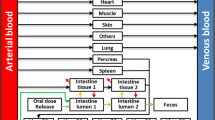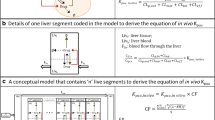Abstract
In the present investigations, we evaluate in vitro hepatocyte uptake and partitioning for the prediction of in vivo clearance and liver partitioning. Monkeys were intravenously co-dosed with rosuvastatin and bosentan, substrates of the organic anion transporting polypeptides (OATPs), and metformin, a substrate of organic cation transporter 1 (OCT1). Serial plasma and liver samples were collected over time. Liver and plasma unbound fraction was determined using equilibrium dialysis. In vivo unbound partitioning (Kpu,u) for rosuvastatin, bosentan, and metformin, calculated from total concentrations in the liver and plasma, were 243, 553, and 15, respectively. A physiologically based pharmacokinetic monkey model that incorporates active and passive hepatic uptake was developed to fit plasma and liver concentrations. In addition, a two-compartment model was used to fit in vitro hepatic uptake curves in suspended monkey hepatocyte to determine active uptake, passive diffusion, and intracellular unbound fraction parameters. At steady-state in the model, in vitro Kpu,u was determined. The results demonstrated that in vitro values under-predicted in vivo active uptake for rosuvastatin, bosentan, and metformin by 6.7-, 28-, and 1.5-fold, respectively, while passive diffusion was over-predicted. In vivo Kpu,u values were under-predicted from in vitro data by 30-, 79-, and 3-fold. In conclusion, active uptake and liver partitioning in monkeys for OATP substrates were greatly under-predicted from in vitro hepatocyte uptake, while OCT-mediated uptake and partitioning scaled reasonably well from in vitro, demonstrating substrate- and transporter-dependent scaling factors. The combination of in vitro experimental and modeling approaches proved useful for assessing prediction of in vivo intracellular partitioning.




Similar content being viewed by others
Abbreviations
- Clup :
-
Unbound active uptake clearance
- Fu:
-
Unbound fraction
- fucell :
-
Intracellular unbound fraction
- Kp:
-
Total tissue partition coefficient
- Kpu,u :
-
Unbound tissue partition coefficient
- OATP:
-
Organic anion transporting polypeptide
- OCT:
-
Organic cation transporter
- PSdiff :
-
Unbound passive diffusion clearance
References
Shitara Y, Maeda K, Ikejiri K, Yoshida K, Horie T, Sugiyama Y. Clinical significance of organic anion transporting polypeptides (OATPs) in drug disposition: their roles in hepatic clearance and intestinal absorption. Biopharm Drug Dispos. 2013;34(1):45–78.
Shitara Y. Clinical importance of OATP1B1 and OATP1B3 in drug-drug interactions. Drug Metab Pharmacokinet. 2011;26(3):220–7.
Shitara Y, Horie T, Sugiyama Y. Transporters as a determinant of drug clearance and tissue distribution. Eur J Pharm Sci. 2006;27(5):425–46.
Hirano M, Maeda K, Shitara Y, Sugiyama Y. Contribution of OATP2 (OATP1B1) and OATP8 (OATP1B3) to the hepatic uptake of pitavastatin in humans. J Pharmacol Exp Ther. 2004;311(1):139–46.
Maeda K, Ieiri I, Yasuda K, Fujino A, Fujiwara H, Otsubo K, et al. Effects of organic anion transporting polypeptide 1B1 haplotype on pharmacokinetics of pravastatin, valsartan, and temocapril. Clin Pharmacol Ther. 2006;79(5):427–39.
Varma MV, Steyn SJ, Allerton C, El-Kattan AF. Predicting clearance mechanism in drug discovery: Extended Clearance Classification System (ECCS). Pharm Res. 2015;32(12):3785–802.
Chu X, Korzekwa K, Elsby R, Fenner K, Galetin A, Lai Y, et al. Intracellular drug concentrations and transporters: measurement, modeling, and implications for the liver. Clin Pharmacol Ther. 2013;94(1):126–41.
Pfeifer ND, Harris KB, Yan GZ, Brouwer KL. Determination of intracellular unbound concentrations and subcellular localization of drugs in rat sandwich-cultured hepatocytes compared with liver tissue. Drug Metab Dispos. 2013;41(11):1949–56.
Duan J, Bolger G, Garneau M, Amad M, Batonga J, Montpetit H, et al. The liver partition coefficient-corrected inhibitory quotient and the pharmacokinetic-pharmacodynamic relationship of directly acting anti-hepatitis C virus agents in humans. Antimicrob Agents Chemother. 2012;56(10):5381–6.
Woodhead JL, Yang K, Siler SQ, Watkins PB, Brouwer KL, Barton HA, et al. Exploring BSEP inhibition-mediated toxicity with a mechanistic model of drug-induced liver injury. Front Pharmacol. 2014;5:240.
Patilea-Vrana G, Unadkat JD. Transport vs. metabolism: what determines the pharmacokinetics and pharmacodynamics of drugs? Insights from the extended clearance model. Clin Pharmacol Ther. 2016;100(5):413–8.
Zamek-Gliszczynski MJ, Kalvass JC, Pollack GM, Brouwer KL. Relationship between drug/metabolite exposure and impairment of excretory transport function. Drug Metab Dispos. 2009;37(2):386–90.
Rose RH, Neuhoff S, Abduljalil K, Chetty M, Rostami-Hodjegan A, Jamei M. Application of a physiologically based pharmacokinetic model to predict OATP1B1-related variability in pharmacodynamics of rosuvastatin. CPT Pharmacometrics Syst Pharmacol. 2014;3:e124.
Li N, Singh P, Mandrell KM, Lai Y. Improved extrapolation of hepatobiliary clearance from in vitro sandwich cultured rat hepatocytes through absolute quantification of hepatobiliary transporters. Mol Pharm. 2010;7(3):630–41.
Watanabe T, Maeda K, Kondo T, Nakayama H, Horita S, Kusuhara H, et al. Prediction of the hepatic and renal clearance of transporter substrates in rats using in vitro uptake experiments. Drug Metab Dispos. 2009;37(7):1471–9.
Soars MG, Grime K, Sproston JL, Webborn PJ, Riley RJ. Use of hepatocytes to assess the contribution of hepatic uptake to clearance in vivo. Drug Metab Dispos. 2007;35(6):859–65.
Jones HM, Barton HA, Lai Y, Bi YA, Kimoto E, Kempshall S, et al. Mechanistic pharmacokinetic modeling for the prediction of transporter-mediated disposition in humans from sandwich culture human hepatocyte data. Drug Metab Dispos. 2012;40(5):1007–17.
Wang L, Prasad B, Salphati L, Chu X, Gupta A, Hop CE, et al. Interspecies variability in expression of hepatobiliary transporters across human, dog, monkey and rat as determined by quantitative proteomics. Drug metabolism and disposition: the biological fate of chemicals 2014.
Shu Y, Sheardown SA, Brown C, Owen RP, Zhang S, Castro RA, et al. Effect of genetic variation in the organic cation transporter 1 (OCT1) on metformin action. J Clin Invest. 2007;117(5):1422–31.
Wang DS, Jonker JW, Kato Y, Kusuhara H, Schinkel AH, Sugiyama Y. Involvement of organic cation transporter 1 in hepatic and intestinal distribution of metformin. J Pharmacol Exp Ther. 2002;302(2):510–5.
Morse BL, Cai H, MacGuire JG, Fox M, Zhang L, Zhang Y, et al. Rosuvastatin liver partitioning in cynomolgus monkeys: measurement in vivo and prediction using in vitro monkey hepatocyte uptake. Drug Metab Dispos. 2015;43(11):1788–94.
Sasabe H, Shimokawa Y, Shibata M, Hashizume K, Hamasako Y, Ohzone Y, et al. Antitubercular agent delamanid and metabolites as substrates and inhibitors of ABC and solute carrier transporters. Antimicrob Agents Chemother. 2016;60(6):3497–508.
Schuhmacher J, Buhner K, Witt-Laido A. Determination of the free fraction and relative free fraction of drugs strongly bound to plasma proteins. J Pharm Sci. 2000;89(8):1008–21.
Reinoso RF, Telfer BA, Brennan BS, Rowland M. Uptake of teicoplanin by isolated rat hepatocytes: comparison with in vivo hepatic distribution. Drug Metab Dispos. 2001;29(4 Pt 1):453–9.
Menochet K, Kenworthy KE, Houston JB, Galetin A. Simultaneous assessment of uptake and metabolism in rat hepatocytes: a comprehensive mechanistic model. J Pharmacol Exp Ther. 2012;341(1):2–15.
Bischoff KB, Dedrick RL, Zaharko DS, Longstreth JA. Methotrexate pharmacokinetics. J Pharm Sci. 1971;60(8):1128–33.
Houston JB. Utility of in vitro drug metabolism data in predicting in vivo metabolic clearance. Biochem Pharmacol. 1994;47(9):1469–79.
Watanabe T, Kusuhara H, Maeda K, Shitara Y, Sugiyama Y. Physiologically based pharmacokinetic modeling to predict transporter-mediated clearance and distribution of pravastatin in humans. J Pharmacol Exp Ther. 2009;328(2):652–62.
Obach RS. Prediction of human clearance of twenty-nine drugs from hepatic microsomal intrinsic clearance data: an examination of in vitro half-life approach and nonspecific binding to microsomes. Drug Metab Dispos. 1999;27(11):1350–9.
Obach RS. The prediction of human clearance from hepatic microsomal metabolism data. Curr Opin Drug Discov Devel. 2001;4(1):36–44.
Iwatsubo T, Hirota N, Ooie T, Suzuki H, Shimada N, Chiba K, et al. Prediction of in vivo drug metabolism in the human liver from in vitro metabolism data. Pharmacol Ther. 1997;73(2):147–71.
Shen H, Yang Z, Mintier G, Han YH, Chen C, Balimane P, et al. Cynomolgus monkey as a potential model to assess drug interactions involving hepatic organic anion transporting polypeptides: in vitro, in vivo, and in vitro-to-in vivo extrapolation. J Pharmacol Exp Ther. 2013;344(3):673–85.
Riccardi K, Lin J, Li Z, Niosi M, Ryu S, Hua W, et al. Novel method to predict in vivo liver-to-plasma Kpuu for OATP substrates using suspension hepatocytes. Drug Metab Dispos. 2017;45(5):576–80.
Yabe Y, Galetin A, Houston JB. Kinetic characterization of rat hepatic uptake of 16 actively transported drugs. Drug Metab Dispos. 2011;39(10):1808–14.
Menochet K, Kenworthy KE, Houston JB, Galetin A. Use of mechanistic modeling to assess interindividual variability and interspecies differences in active uptake in human and rat hepatocytes. Drug Metab Dispos. 2012;40(9):1744–56.
Li R, Ghosh A, Maurer TS, Kimoto E, Barton HA. Physiologically based pharmacokinetic prediction of telmisartan in human. Drug Metab Dispos. 2014;42(10):1646–55.
Umehara KI, Iwatsubo T, Noguchi K, Kamimura H. Functional involvement of organic cation transporter1 (OCT1/Oct1) in the hepatic uptake of organic cations in humans and rats. Xenobiotica. 2007;37(8):818–31.
Lozano E, Herraez E, Briz O, Robledo VS, Hernandez-Iglesias J, Gonzalez-Hernandez A, et al. Role of the plasma membrane transporter of organic cations OCT1 and its genetic variants in modern liver pharmacology. Biomed Res Int. 2013;2013:692071.
Burt HJ, Neuhoff S, Almond L, Gaohua L, Harwood MD, Jamei M, et al. Metformin and cimetidine: physiologically based pharmacokinetic modelling to investigate transporter mediated drug-drug interactions. Eur J Pharm Sci. 2016;88:70–82.
Chen EC, Liang X, Yee SW, Geier EG, Stocker SL, Chen L, et al. Targeted disruption of organic cation transporter 3 attenuates the pharmacologic response to metformin. Mol Pharmacol. 2015;88(1):75–83.
Liang X, Chien HC, Yee SW, Giacomini MM, Chen EC, Piao M, et al. Metformin is a substrate and inhibitor of the human thiamine transporter, THTR-2 (SLC19A3). Mol Pharm. 2015;12(12):4301–10.
Jensen JB, Sundelin EI, Jakobsen S, Gormsen LC, Munk OL, Frokiaer J, et al. [11C]-Labeled metformin distribution in the liver and small intestine using dynamic positron emission tomography in mice demonstrates tissue-specific transporter dependency. Diabetes. 2016;65(6):1724–30.
Tanihara Y, Masuda S, Sato T, Katsura T, Ogawa O, Inui K. Substrate specificity of MATE1 and MATE2-K, human multidrug and toxin extrusions/H(+)-organic cation antiporters. Biochem Pharmacol. 2007;74(2):359–71.
Zamek-Gliszczynski MJ, Bao JQ, Day JS, Higgins JW. Metformin sinusoidal efflux from the liver is consistent with negligible biliary excretion and absence of enterohepatic cycling. Drug Metab Dispos. 2013;41(11):1967–71.
Acknowledgements
This study is supported by Bristol-Myers Squibb Company.
Author information
Authors and Affiliations
Contributions
Morse, Lai, Humphreys, Marathe, Shen, and MacGuire participated in research design. MacGuire, Fox, Zhao, Zhang, Marino, and Morse conducted the experiments. MacGuire, Morse, and Lai contributed new reagents or analytic tools. Morse, Lai, Zhao, and Marino performed data analysis. Morse, Lai, MacGuire, Marathe, Humphreys, Zhao, and Shen wrote or contributed to the writing of the manuscript.
Corresponding author
Rights and permissions
About this article
Cite this article
Morse, B.L., MacGuire, J.G., Marino, A.M. et al. Physiologically Based Pharmacokinetic Modeling of Transporter-Mediated Hepatic Clearance and Liver Partitioning of OATP and OCT Substrates in Cynomolgus Monkeys. AAPS J 19, 1878–1889 (2017). https://doi.org/10.1208/s12248-017-0151-z
Received:
Accepted:
Published:
Issue Date:
DOI: https://doi.org/10.1208/s12248-017-0151-z




